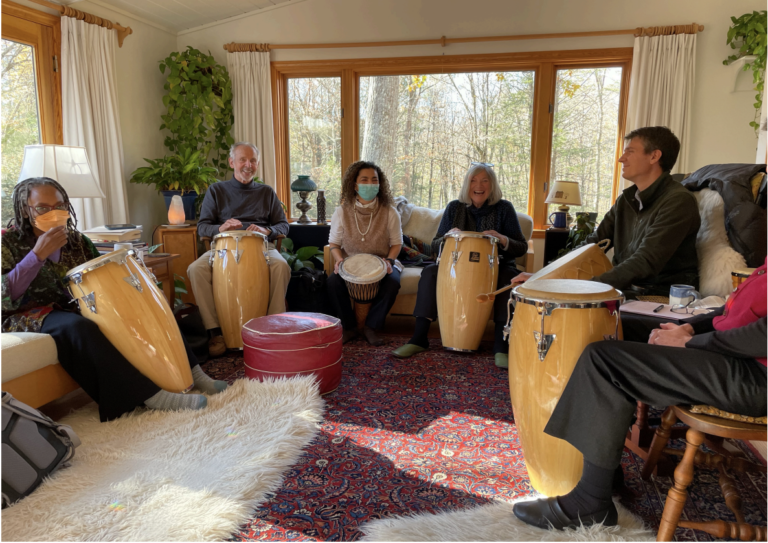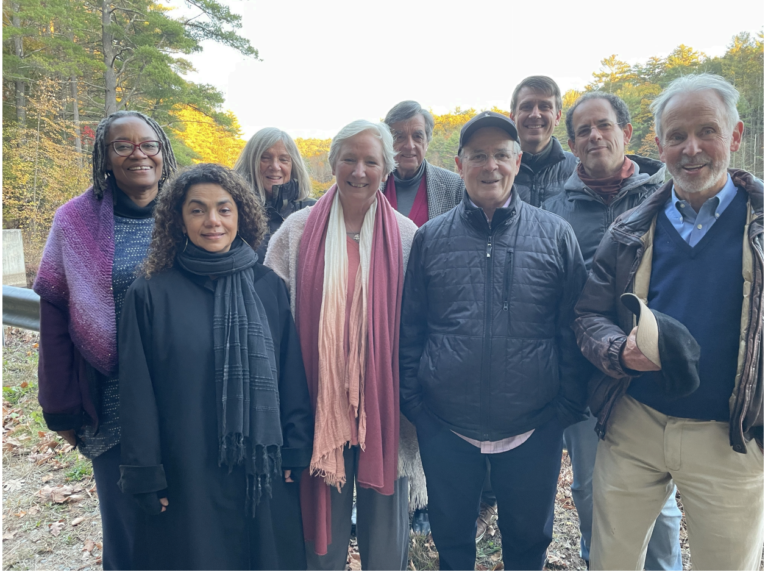
pedagogical section newsletter
november 2022
Dear Colleagues and Friends of the Pedagogical Section:
Like the changing seasons, the rhythms of life are never ending. One of them takes the form of comings and goings in the Pedagogical Section Council itself. We first want to say goodbye to two stalwarts who have spent many years volunteering their time on the Council and working tirelessly to share the depths of their knowledge with the rest of us.
Ina Jaehnig, a long-time teacher at the Denver Waldorf School, stepped down from the Council in January of this year. Ina is known to many of you through her offerings in regional and national conferences and her teaching at the Waldorf Teacher Education Eugene in Oregon. On the Council, she made lasting contributions to the study of the First Class Lessons and the accompanying mantras. With modesty that could not hide years of contemplative engagement with these lessons, Ina presented thoughtful discussions and depths of research each morning, and her offerings built sturdy foundations for everything that followed during the rest of our meetings. To work with her was to sense what Rudolf Steiner meant when he spoke of those who are able to bestow grace on their environment in their later years.
In January 2023, Betty Staley will host our next meeting at her home in Fair Oaks (Covid and the State of California permitting) as her final act of hospitality and collaboration on the Council. Betty, as most people know, is where the Energizer Bunny goes for pep talks when it runs out of juice. A tireless teacher, mentor, author, and lecturer, she has spent more than 50 years practicing and advocating for Waldorf education. Betty brought to the Council a remarkable ability to generate conversation. Ever attentive to what students, teachers, and the culture at large were asking of education, she never shied away from doing the necessary research and asking tough questions. Her books are beloved guides for teachers and parents alike, and she often brought a breadth of contemporary knowledge that greatly enhanced the Council’s conversations.
On behalf of everyone who cares about Waldorf education on this continent, I would like to thank Ina and Betty most warmly for their many years of service on the Council. We were greatly enriched for the presence among us.

With departures come opportunities for new members to join. The Council is pleased to announce two new members:
Linda Williams, known to many of you, has been active in Waldorf education since 1985, spending most of her years at the Detroit Waldorf School as a class teacher, but also teaching at the Milwaukee Urban Waldorf school and at the college level. Linda is currently the pedagogical mentor at the Detroit school, an AWSNA Board member, and one of the leading voices in the field of diversity in its different incarnations (multiculturalism, DEI, and recently with an emphasis on what she calls “a pedagogy of belonging”). We are thrilled that she has agreed to join our circle. Her first assignment on behalf of the Council was to help lead a team working to build a North American version of an online tool for curriculum design first developed in the UK.
Victoria Reyes joins us from the Austin Waldorf School, where she is a high school English and history teacher. Victoria took the lead in the start of the Council’s most recent research project. The daughter and granddaughter of Afro-indigenous Colombian drummers, she guided us through an experience of drumming (perhaps the most fun research activity we have ever undertaken) as a foundation for examining when, why, and how one might want to incorporate drumming into the Waldorf curriculum. (See Picture above). Drumming came up in conversations the PSC had with colleagues who are part of AWSNA’s BIPOC group, and we decided to take it up as a research question. We will continue this exploration and bring you thoughts in the future.
Both Linda and Victoria were present at the Council’s most recent meeting in late October – our first in-person meeting since January 2020. We gathered at the home of James Pewtherer and Jan Baudendistel in Western Massachusetts, and the experience of sitting in one room and sensing the space between us fill up with intention and focus was a profound reminder of what we had lost during the Covid years. A flat computer screen, while allowing an exchange of thoughts and images of one another, provides no living, breathing space. This is not a new thought, of course, but until one sits across from faces that have been visible only as pixels for almost three years, one can easily forget just how powerful an experience it is to be working with colleagues in the same physical space.

Back row from left: Linda Williams, Frances Vig, Douglas Gerwin, Vernon Dewey, Elan Leibner Front Row: Victoria Reyes, Laura Radefeld, Michael Holdrege, James Pewtherer Missing: Holly Koteen-Soulé, Betty Staley On leave: Jennifer Snyder.
As we heard from one another and from Susan Howard, who joined us on Zoom for a conversation about the Waldorf early childhood movement, a few themes are rising to the surface among Waldorf educators as a consequence of the pandemic:
• Children, especially those who were in early childhood programs and the initial years of grade school, show developmental delays and, in many cases, symptoms of trauma-like gaps in social, emotional, and cognitive development.
• Teacher burnout: the stress of the last few years is showing itself in symptoms of exhaustion and low morale. New demands and challenges have been added to all the stresses that always attend this profession, and many school leaders speak of a need for inspiration in the ranks.
• Related to the burnout issue: consciousness among teachers concerning the role of the night in education was felt to be weakened or missing altogether when Council members visited schools. When teachers do not involve the spiritual world in the rhythms of their lessons, feeling alone and without help becomes an almost inevitable consequence.
As a result of these observations, the Council is proposing that schools take up the twin themes of “the night” and “meditation” so that teachers can strengthen their connection with the wellsprings of inspiration and professional vitality. A few suggested practices are noted below. Each can be the topic of conversation and study:
Sleep:
• Planning lessons so there is always something sent into the night and then, on the following day, brought back from the night. In this way, the teacher invites the spiritual world to partake in the educational process.
• Sleep itself: physiological aspects and their anthroposophical perspectives.
• Preparation for sleep: reviewing the events of the day in reverse (Rückschau).
• Sending one’s pedagogical questions (regarding individual children, e.g.) into the night.
• Return from sleep: attending to insights that may come from the night.
• Conversations with parents about age-appropriate transitions into sleep.
Here are a few suggested lectures for studying sleep itself. All are available on www.rsarchive.org:
• “Experience of the Soul in Sleep” (in GA 215, September 10, 1922)
• “The Concealed Aspects of Human Existence and the Christ Impulse” (in GA 218, November 5, 1922). In the same lecture cycle: lecture of October 9, 1922.
• GA 227 (lectures of August 21, 22, 23, 26, 27, 1923)
• GA 226 (lecture of May 19, 1923)
Meditation:
Steiner based everything he did with the first Waldorf teachers on the assumption that they were practitioners of meditation. The imagination of the circle of teachers forming an organ of spiritual perception (often called The College Imagination, The Chalice Imagination, or The Angel Imagination) begins with the spiritual meeting of the individuals with their angel. Steiner gave the teachers not one but two professional meditations and mentioned specifically how taking his lectures into meditation could enhance their capacities as teachers (e.g., in lecture 3 of Balance in Teaching, GA 302a, September 21, 1920).
Faculties can discuss methods and challenges on the meditative path, using resources widely available in the anthroposophical literature. Ultimately, without meditative practice there is no Waldorf pedagogy. The essential task of education is to help incarnating children negotiate the obstacles on the path towards realizing their pre-birth intentions. Meditation is our tool for coming to what Steiner called “Waldorf Teacher’s Consciousness, which can only be developed when, in the field of education, we come to an actual experience of the spiritual.” (Lecture of October 16, 1923). He challenged us to develop what we may call “pedagogical clairvoyance” even if we do not yet have the capacity to see into the spiritual world otherwise.
The wonderful thing about embarking on a meditative practice is that everything that makes Waldorf education magical, in the best sense of that word, begins to find its way into our work. Subtly and imperceptibly, we become collaborators with benevolent spiritual beings, and the resolve to carry on in the face of the immense challenges that this work presents grows strong within us. Let us share our striving in this sphere with like-minded colleagues.
Also, a reminder that PSC publications can be ordered from Waldorf Publications (www.waldorfpublications.org). Sales of these books support the Council’s work.
And speaking of Waldorf Publications, it behooves us to send a huge shout-out to Patrice Maynard and her team. They have been handling both the sale of our books and our annual appeal for years now. Their selfless and unpaid help has been immensely significant in getting the word out and garnering support for the Council’s work. Thank you!
With warmest greetings on behalf of the Pedagogical Section Council,
Elan Leibner
Chair, PSC
